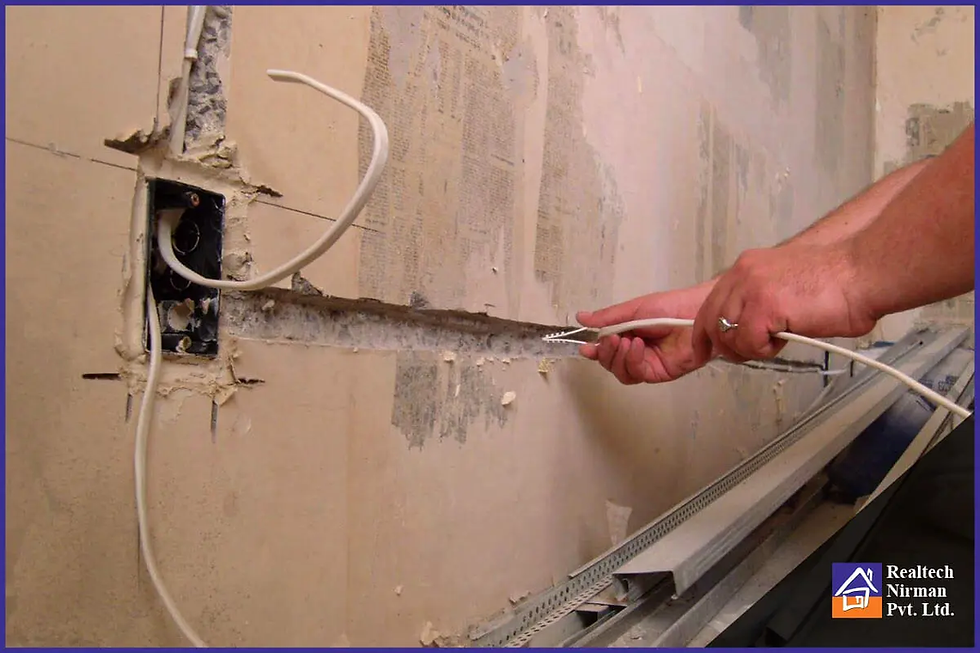Home Wiring Service: Why You Should Conceal Wires Inside Walls (2026 Guide)
- Epul Naim

- 1 minute ago
- 3 min read
Table of Contents

Introduction
Messy exposed wires on the wall look untidy and unsafe? Here’s why concealed wiring is the top choice for modern homeowners.
In today’s home renovation scene, more Malaysian homeowners are choosing concealed wiring — not just for aesthetics, but for safety, electrical system longevity, and easier maintenance.
This article breaks down exactly why hiding wires in your walls is a smart investment for your home in 2026.

1. What Is Concealed Wiring & How Is It Done?
Concealed wiring means electrical cables are hidden inside the wall, ceiling, or floor.
🔧 Common process involves:
Chiselling wall grooves
Installing PVC pipes/conduits
Inserting cables and resealing with plaster or cement
✅ Commonly used for:
New lighting & socket points
Aircon & water heater systems
CCTV, main switches, and DB box

2. Benefits of Concealed Wiring vs Surface Wiring
🏡 Key advantages of concealed wiring:
Sleek & modern appearance — no messy wires
Protected from physical damage — pets, foot traffic
Easier to install plaster ceilings or wall panels
Lower risk of electric shock — cables are shielded in pipes
Higher property value — buyers are more confident in a safe electrical system
More interior contractors now recommend concealed wiring for both small- and large-scale renovations.
3. Risks of Not Hiding Wires in the Wall
⚠️ Surface wiring may:
Be easily damaged by water or furniture
Have a shorter lifespan, especially when clipped externally
Cause fire hazards if cables come loose or exposed
Diminish the aesthetics of your interior
If you plan to stay long-term or build your own house, avoid surface wiring as a permanent solution.

4. When Is the Right Time to Do Concealed Wiring?
🕒 Best times for concealed wiring:
Before major renovations
During kitchen, bathroom, or living room makeovers
When buying a subsale home and upgrading the electrical system
If old cables are worn or the DB box trips frequently
Concealed wiring is difficult if the house is already furnished or occupied — so plan early!
5. Estimated Cost of House Wiring Services in 2026
💰 Costs depend on:
House type (terrace, apartment, bungalow)
Number of lighting & socket points
Cable length & DB box location
Finishing style (standard plaster vs premium finish)
Price estimates:
Socket point: RM90 – RM130 per unit
Lighting point: RM80 – RM120 per unit
DB Box + full rewiring upgrade: RM1,800 – RM4,000
Did You Know?
Homes with concealed wiring are more likely to pass TNB or local council inspections
Many home insurance policies now require in-wall wiring for fire coverage
High-quality wires hidden in conduits can last up to 20 years with no issues
Conclusion
If you value safety, aesthetics, and long-lasting performance — concealed wall wiring is a smart investment.
Always ensure the job is handled by a licensed electrician — not just to avoid technical issues, but to meet insurance and legal compliance.
FAQs About Concealed Wiring
Q: Do I need a permit to do wiring work in my house?
A: No permit is needed for private homes, but work must be done by a certified electrician for safety.
Q: How long does concealed wiring take?
A: Depending on the house size, usually between 1–4 days.
Q: Is concealed wiring suitable for old homes?
A: Yes, but extra care is needed for old structures and existing furniture.
Q: What’s the difference between concealed wiring and surface conduit wiring?
A: Concealed wiring is hidden within the wall — more aesthetic and safer. Surface conduit is visible and usually used in industrial settings.
Q: Can I do concealed wiring myself?
A: Not recommended unless you're certified — high risk of shock or fire.
🛠️ Want a safer, modern & cleaner home? We’re here to help:
✅ Concealed wiring for new or renovated homes
✅ DB box upgrades & old wiring replacements
✅ Add lighting, sockets, switches & aircon support
✅ CCTV, heater, fan & other appliance wiring
💡 Affordable pricing. Clean & safe results according to ST standards.









Comments